ISSN ONLINE(2278-8875) PRINT (2320-3765)
ISSN ONLINE(2278-8875) PRINT (2320-3765)
Manimaran. V. B1, Mrs. R. Mahalakshmi M.E (Ph.d)2
|
| Related article at Pubmed, Scholar Google |
Visit for more related articles at International Journal of Advanced Research in Electrical, Electronics and Instrumentation Engineering
Nowadays, world demands energy conservation due to the replenishment of the non-renewable energies such as coal, petroleum and natural gas. In developing countries like India, power consumption plays a vital role since the replenishment of the coal in the power plant. This project provides an innovative solution to the power demand by using renewable energy such as wind and solar. In this project both the wind and solar are combined together to get the desired amount of energy. This configuration allows the two sources to supply the load separately or simultaneously depending on the power demand. Because of the inherent nature of this Cuk-SEPIC fused converter, additional input filters are not necessary to filter out high frequency h a r mo n i c s . Simulation results are used to highlight the merits of the proposed circuits
Keywords |
| Solar, Wind, Cuk-SEPIC, Hybrid |
I. INTRODUCTION |
| With increasing concern in renewable energy systems with various sources becomes greater than before. Renewable energy sources such as photovoltaic (PV) and wind energy can be used to enhance the safety, reliability, and sustainability of a power system. Renewable energy resources will be increasingly an important part of power generation in the new millennium . There is an enormous need for integrated power converters that are capable of interfacing and controlling several power terminals with low cost and compact structure. The utilization of natural energy is recognized as a new energy source which will eventually replace conventional energy sources. Renewable energy sources do not have the high external cost and social issues. Renewable energy sources such as wind, solar, fuel cell holds more potential to meet our energy demands. This proposal focuses on control of two major renewable-energy sources: PV and wind energy. |
II. HYBRID ENERGY |
| Hybrid Renewable Energy systems (HRES) are becoming popular for remote area power generation applications due to advances in renewable energy technologies and subsequent rise in prices of petroleum products. A hybrid energy system usually consists of two or more renewable energy sources used together to provide increased system efficiency as well as greater balance in energy supply. |
III. WIND ENERGY |
| Wind energy is the fastest-growing renewable source of clean energy. It has shown its great potential for combating climatic change, ensuring clean and efficient energy. It can make major contribution towards satisfying the global need for clean and RES . For modeling the energy produced by wind power, all components in the system is to be modeled. First the wind turbine has to be modeled, including the mechanical drive train, such as shafts, gearboxes and bearings. Second the electrical machine, mostly a synchronous machine is modeled in detail and connected to a model of the power electronics, such as controlled rectifiers or back to back converters. |
IV. SOLAR ENERGY |
| Photovoltaic (PV) offers an environmentally friendly source of electricity. Worldwide, photovoltaics account for 500 MW of power generation with an annual growth rate greater than 20% . In the near future photovoltaic power is expected to become more cost effective and will be almost price competitive with traditional sources of energy. With development and breakthrough in new cell materials and power electronics technologies solar power can prove to be an efficient, environmental friendly and safe means of power. In this module the solar cells is a fundamental power conversion unit of a photovoltaic system.Due to the fact that solar and wind energy source is intermittent and quite variable, longitude, latitude, weather and limited daytime should be considered in acquiring electrical energy from PV system and wind turbine system and also it is possible that power fluctuations can be observed since photovoltaic and wind power source is highly dependent on the weather conditions.In the near future using hybrid systems for electricity generation may have more profitable in parallel with the technological advances. Photovoltaic and wind systems are the source of energy in standalone systems.. The easy installation and maintenance free operational feature of the hybrid system created more popularity among the rural masses. |
Hybrid Energy Model |
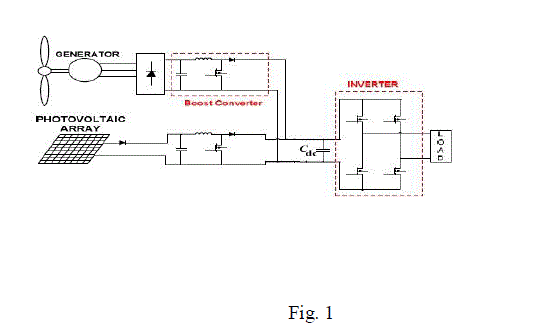 |
| Wind and solar power are given as input to the converter. Wind model and solar model are separately modeled. In this proposed model, a hybrid system with multi input integrated converter structure is proposed. The circuit consists of integrated cUk-sepic converters. The inherent nature of the proposed converter is that, it does not require additional input filters to filter out the frequency harmonics. The output from converteris given to inverter which converts dc to ac and is applied to load. The load used hereisresistive load. By using these converters, step up and step down operations can be done. The proposed converter is valuable for renewable energy harvesting applications. |
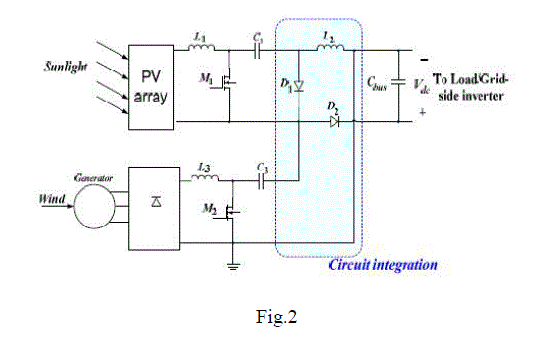 |
| A system diagram of the proposed rectifier stage of a hybrid energy system is shown in Figure 2, where one of the inputs is connected to the output of the PV array and the other input connected to the output of a generator. The fusion of the two converters is achieved by reconfiguring the two existing diodes from each converter and the shared utilization of the Cuk output inductor by the SEPIC converter. This configuration allows each converter to operate normally individually in the event that one source is unavailable. Figure 3 illustrates the case when only the wind source is available. In this case, D1 turns off and D2 turns on; the proposed circuit becomes a SEPIC converter and the input to output voltage relationship is given by (1). On the other hand, if only the PV source is available, then D2 turns off and D1 will always be on and the circuit becomes a Cuk converter as shown in Figure 4. |
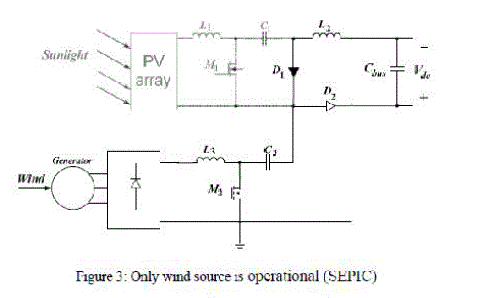 |
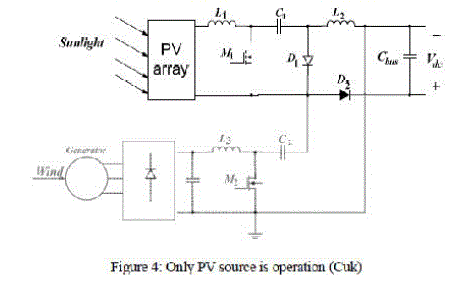 |
| Figure 5 illustrates the various switching states of the proposed converter. If the turn on duration of M1 is longer than M2, then the switching states will be state I, II, IV. Similarly, the switching states will be state I, III, IV if the switch conduction periods are vice versa. To provide a better explanation, the inductor current waveforms of each switching state are given as follows assuming that d2>d1; hence only states I, III, IV are discussed in this example. In the following, Ii,PV is the average input current from the PV source; Ii,W is the RMS input current after the rectifier (wind case); and Idc is the average system output current. The key waveforms that illustrate the switching states in this example are shown in Figure 6. The mathematical expression that relates the total output voltage and the two input |
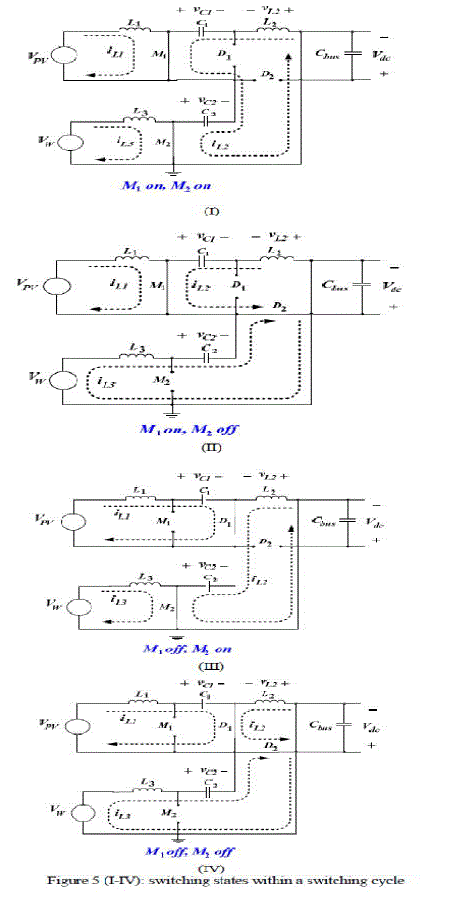 |
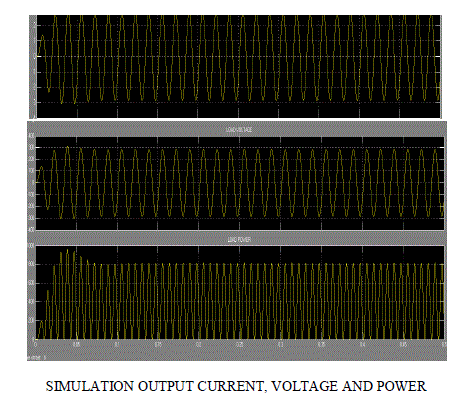 |
V. CONCLUSION & FUTURE WORK |
| The hybrid wind and solar power generation can be used to generate large amount of power at almost all times of a day. This can be an alternative source of energy to the non-renewable resources. This can be implemented instead of a single source , to gain more power almost at all times. The generation of hybrid wind and solar power has been simulated using Mat lab software and output waveform for voltage, current and power have been obtained which provide the comprehensive and constructive knowledge about the same system in hardware. The hybrid wind and solar system will be implemented in hardware with specified components. |
ACKNOWLEDGMENT |
| The author is thankful toMrs.K.Kanchana, Department of Electrical and Electronics Engineering, Saveetha Engineering College for the technical support. He, indebted to Head of the Department Dr. R. Senthil Kumar for his support during entire course of project |
References |
|